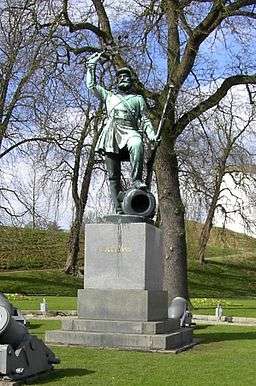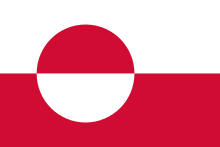Fredericia
| Fredericia | ||
| Town | ||
 The statue Landsoldaten ("The Foot Soldier") in Fredericia, Denmark | ||
|
||
| Country | Denmark | |
|---|---|---|
| Region | Southern Denmark (Syddanmark) | |
| Municipality | Fredericia | |
| Elevation | 15 m (49 ft) | |
| Coordinates | DK 55°34′N 9°45′E / 55.567°N 9.750°ECoordinates: DK 55°34′N 9°45′E / 55.567°N 9.750°E | |
| Population | 39,922 (2014) | |
| Founded | 1650 | |
| - Current municipality | 1970 | |
| Timezone | CET (UTC+1) | |
| - summer (DST) | CEST (UTC+2) | |
| Postal code | 7000 | |
| Area code | (+45) 72 | |
 Location in Denmark | ||
| Website: www.fredericia.dk | ||

Fredericia (Danish pronunciation: [fʀɛðəˈʀeɕa]) is a town located in Fredericia municipality in the eastern part of the Jutland peninsula in Denmark, in a sub-region known locally as Trekanten, or The Triangle. It was founded in 1650 by Frederick III, after whom it was named.
The city itself has a population of 39,922 January 2014)[1] and the Fredericia municipality has a population of 50,324 (2014).
History
After the devastation caused by the Thirty Years War in a largely unfortified Jutland, King Christian IV realized the necessity of building a strong fortress in Jutland, and decided that this project could be combined with his plans for building a large town in Jutland.
A fortified encampment was built on a point of land called Lyngs Odde, near the current location of Fredericia, with a rampart stretching to either side of the point, thus protecting the encampment from attacks. However, the fortifications were not perfect, and when Swedish Field Marshal Lennart Torstenson invaded Jutland, he was able to break through the ramparts. It was Frederick III who was finally able to complete the plans for the fortification, also adding a flank fortification on nearby Bers Odde as suggested by Danish Imperial Marshal Anders Bille.
On 15 December 1650, the King signed the document giving the town its first privileges, and work on the new fortifications could begin. In 1651, the town was named Frederiksodde (Frederick's Point) after the king, and on 22 April 1664, it was given the new Latinized name of Fredericia.
Every 6 July, the town of Fredericia holds a festival to commemorate the 1849 Battle of Fredericia, fought during the First War of Schleswig, in which Danish troops won a victory over the Schleswig-Holstein rebels who were laying siege to the town. Fredericia's landmark, Landsoldaten, was unveiled on 6 July 1858.[2]
Present
The municipality today is part of the East Jutland metropolitan area with 1.2M inhabitants,[3] and is the site of Fredericia municipality's municipal council.
The town is one of Denmark's largest traffic hubs.
The town is a major barracks, home to the Royal Danish Army's army's Signals Regiment (Telegrafregimentet), which is located at Rye's Barracks (Ryes Kaserne) and Bülow's Barracks (Bülows Kaserne).
Notable people
- Cecil Bødker (1927–present), writer and poet
- Erik Holtved (1899–1981), ethnologist
- Jørgen Vig Knudstorp (1968–present), businessman and head of Lego Group
- Svend Melsing (1888–1946), actor, theatre director and playwright
- Henrik Pontoppidan (1857–1943), writer
- Thomas Sørensen (1976–present), footballer
Twin towns
 Kokkola, Finland, 1948
Kokkola, Finland, 1948 Kristiansund, Norway, since 1948
Kristiansund, Norway, since 1948 Härnösand, Sweden, since 1948
Härnösand, Sweden, since 1948 Ilulissat, Greenland, since 1962
Ilulissat, Greenland, since 1962 Herford, Germany, since 1987
Herford, Germany, since 1987 Šiauliai, Lithuania, since 1993
Šiauliai, Lithuania, since 1993
See also
References
- ↑ "BEF44: Population 1st January, by urban areas" database from Statistics Denmark
- ↑ http://www.assistens.dk/bissen.htm
- ↑ Vision Østjylland (PDF) (in Danish). Styregruppen for projekt Byudvikling i Østjylland. Retrieved 12 September 2013.
External links
| Wikimedia Commons has media related to Fredericia. |
| Wikisource has the text of the 1905 New International Encyclopedia article Fredericia. |
 Fredericia travel guide from Wikivoyage
Fredericia travel guide from Wikivoyage
